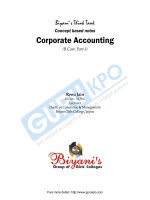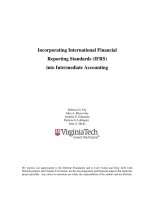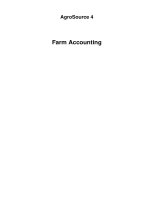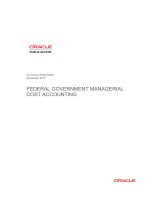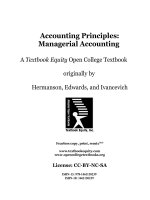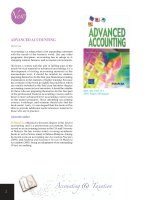ADVANCED ACCOUNTING ppt
Bạn đang xem bản rút gọn của tài liệu. Xem và tải ngay bản đầy đủ của tài liệu tại đây (5.77 MB, 839 trang )
This page intentionally left blank
ADVANCED
ACCOUNTING
Editorial Director: Sally Yagan
Editor in Chief: Donna Battista
Director of Editorial Services: Ashley Santora
Senior Editorial Project Manager: Karen Kirincich
Editorial Assistant: Jane Avery
Director of Marketing: Patrice Jones
Marketing Assistant: Ian Gold
Senior Managing Editor: Cindy Zonneveld
Production Project Manager: Carol O’Rourke
Senior Art Director: Jonathan Boylan
Interior Design: Jonathan Boylan
Cover Designer: Jonathan Boylan
Composition: PreMediaGlobal
Full-Service Project Management: Kristy Zamagni
Senior Operations Specialist: Diane Peirano
Printer/Binder: Edwards Brothers
Cover Printer: Demand Production Center
Typeface: 10/12 Times
Credits and acknowledgments borrowed from other sources and reproduced, with permission, in this textbook appear on
appropriate page within text.
The GASB Statement No. 33, Accounting for Financial Reporting for Nonexchange Transactions, Appendix C summary
chart, “Classes and Timing of Recognition of Nonexchange Transactions,” copyright by the Governmental Accounting
Standards Board, 401 Merritt 7, Norwalk, CT 06856-5116, U.S.A., is reprinted with permission. Complete copies of this
document are available from the GASB.
Copyright © 2012, 2009, 2006, 2003, 2000 by Pearson Education, Inc., Upper Saddle River, New Jersey, 07458.
Pearson Prentice Hall. All rights reserved. Printed in the United States of America. This publication is protected by
copyright and permission should be obtained from the publisher prior to any prohibited reproduction, storage in a
retrieval system, or transmission in any form or by any means, electronic, mechanical, photocopying, recording, or
likewise. For information regarding permission(s), write to: Rights and Permissions Department.
Pearson Prentice Hall™ is a trademark of Pearson Education, Inc.
Pearson® is a registered trademark of Pearson plc
Prentice Hall® is a registered trademark of Pearson Education, Inc.
Pearson Education Ltd., London
Pearson Education Singapore, Pte. Ltd
Pearson Education, Canada, Inc.
Pearson Education–Japan
Pearson Education Australia PTY, Limited
Pearson Education North Asia, Ltd., Hong Kong
Pearson Education de Mexico, S.A. de C.V.
Pearson Education Malaysia, Pte. Ltd
Pearson Education Upper Saddle River, New Jersey
CIP data is on le at the Library of Congress.
10 9 8 7 6 5 4 3 2 1
ISBN-13: 978-0-13-256896-8
ISBN-10: 0-13-256896-9
ELEVENTH EDITION
ADVANCED
ACCOUNTING
Floyd A. Beams
Virginia Polytechnic Institute
and State University
Joseph H. Anthony
Michigan State University
Bruce Bettinghaus
Grand Valley State University
Kenneth A. Smith
University of Washington
This page intentionally left blank
In memory of Madeline To Trish To Karen, Madelyn and AJ
JOE ANTHONY BRUCE BETTINGHAUS KENNETH A. SMITH
This page intentionally left blank
ABOUT THE
AUTHORS
FLOYD A. BEAMS, PH.D., authored the first edition
of Advanced Accounting in 1979 and actively revised his text
through the next six revisions and twenty-one years while main-
taining an active professional and academic career at Virginia
Tech where he rose to the rank of Professor, retiring in 1995.
Beams earned his B.S. and M.A. degrees from the Univer-
sity of Nebraska, and a Ph.D. from the University of Illinois. He
published actively in journals including The Accounting Review ,
Journal of Accounting, Auditing and Finance, Journal of Account-
ancy, The Atlantic Economic Review, Management Accounting ,
and others. He was a member of the American Accounting Asso-
ciation and the Institute of Management Accountants and served
on committees for both organizations. Beams was honored with
the National Association of Accounts’ Lybrand Bronze Medal
Award for outstanding contribution to accounting literature, the
Distinguished Career in Accounting award from the Virginia
Society of CPAs, and the Virginia Outstanding Accounting Edu-
cator award from the Carman G. Blough student chapter of the
Institute of Management Accountants. Professor Beams passed
away three years ago; however, we continue to honor his contri-
bution to the field, and salute the impact he had on this volume.
JOSEPH H. ANTHONY, PH.D., joined the Michigan
State University faculty in 1983 and is an Associate Professor of
Accounting at the Eli Broad College of Business. He earned his
B.A. in 1971 and his M.S. in 1974, both awarded by Pennsylvania
State University, and he earned his Ph.D. from The Ohio State
University in 1984. He is a Certified Public Accountant, and is
a member of the American Accounting Association, American
Institute of Certified Public Accountants, American Finance
Association, and Canadian Academic Accounting Association.
He has been recognized as a Lilly Foundation Faculty Teaching
Fellow and as the MSU Accounting Department’s Outstanding
Teacher in 1998–99 and in 2010–2011.
Anthony teaches a variety of courses, including undergradu-
ate introductory, intermediate, and advanced financial account-
ing. He also teaches financial accounting theory and financial
statement analysis at the master’s level, as well as financial
accounting courses in Executive MBA programs, and a doctoral
seminar in financial accounting and capital markets research.
He co-authored an introductory financial accounting textbook.
Anthony’s research interests include financial statement
analysis, corporate reporting, and the impact of accounting
information in the securities markets. He has published a number
of articles in leading accounting and finance journals, includ-
ing The Journal of Accounting & Economics, The Journal of
Finance, Contemporary Accounting Research, The Journal of
Accounting, Auditing, & Finance , and Accounting Horizons .
BRUCE BETTINGHAUS, PH.D., is an Assistant
Professor of Accounting in the School of Accounting in The
Seidman College of Business at Grand Valley State University.
His teaching experience includes corporate governance and
accounting ethics, as well as accounting theory and financial
reporting for both undergraduates and graduate classes. He
earned his Ph.D at Penn State University and his B.B.A. at
Grand Valley State University. Bruce has also served on the
faculties of the University of Missouri and Michigan State
University. He has been recognized for high quality teaching
at both Penn State and Michigan State universities. His
research interests focus on governance and financial reporting
for public firms. He has published articles in The International
Journal of Accounting and The Journal of Corporate
Accounting and Finance .
KENNETH A. SMITH , PH.D., is a Senior Lecturer in
the Evans School of Public Affairs at the University of Wash-
ington. He earned his Ph.D. from the University of Missouri,
his M.B.A. from Ball State University and his B.A. in Account-
ing from Anderson University (IN). He is a Certified Public
Accountant. Smith’s research interests include government
accounting and budgeting, non-profit financial management,
non-financial performance reporting and information systems
in government and non-profit organizations. He has published
articles in such journals as Accounting Horizons, Journal of
Government Financial Management, Public Performance &
Management Review, Nonprofit and Voluntary Sector Quar-
terly, International Public Management Journal, Government
Finance Review, and Strategic Finance.
Smith’s professional activities include membership in
the American Accounting Association, the Association of
Government Accountants, the Government Finance Officers
Association, the Institute of Internal Auditors, and the Institute
of Management Accountants. He serves on the Steering
Committee for the Public Performance Measurement Reporting
Network and as the Executive Director for the Oregon Public
Performance Measurement Association.
vii
This page intentionally left blank
BRIEF
CONTENTS
Preface xvii
CHAPTER 1
Business Combinations 1
CHAPTER 2
Stock Investments—Investor Accounting
and Reporting 27
CHAPTER 3
An Introduction to Consolidated Financial Statements 63
CHAPTER 4
Consolidation Techniques and Procedures 99
CHAPTER 5
Intercompany Pro t Transactions—Inventories 145
CHAPTER 6
Intercompany Pro t Transactions—Plant Assets 185
CHAPTER 7
Intercompany Pro t Transactions—Bonds 219
CHAPTER 8
Consolidations—Changes in Ownership Interests 247
CHAPTER 9
Indirect and Mutual Holdings 279
CHAPTER 10
Subsidiary Preferred Stock, Consolidated Earnings per
Share, and Consolidated Income Taxation 315
CHAPTER 11
Consolidation Theories, Push-Down Accounting, and
Corporate Joint Ventures 369
CHAPTER 12
Derivatives and Foreign Currency: Concepts and Common
Transactions 409
CHAPTER 13
Accounting for Derivatives and Hedging Activities 429
CHAPTER 14
Foreign Currency Financial Statements 463
CHAPTER 15
Segment and Interim Financial Reporting 497
CHAPTER 16
Partnerships—Formation, Operations, and Changes
in Ownership Interests 525
CHAPTER 17
Partnership Liquidation 561
CHAPTER 18
Corporate Liquidations and Reorganizations 591
CHAPTER 19
An Introduction to Accounting for State and Local
Governmental Units 625
CHAPTER 20
Accounting for State and Local Governmental
Units—Governmental Funds 663
CHAPTER 21
Accounting for State and Local Governmental
Units—Proprietary and Fiduciary Funds 711
CHAPTER 22
Accounting for Not-for-Pro t Organizations 737
CHAPTER 23
Estates and Trusts 775
Glossary G-1
Index I-1
ix
This page intentionally left blank
CONTENTS
Preface xvii
CHAPTER 1
Business Combinations 1
Reasons for Business Combinations 2
Antitrust Considerations 3
Legal Form of Business Combinations 4
Accounting Concept of Business Combinations 4
Accounting for Combinations as Acquisitions 6
Disclosure Requirements 15
The Sarbanes-Oxley Act 17
Electronic Supplement to Chapter 1 ES1
CHAPTER 2
Stock Investments—Investor Accounting and Reporting 27
Accounting for Stock Investments 27
Equity Method—a One-Line Consolidation 31
Investment in a Step-by-Step Acquisition 39
Sale of an Equity Interest 39
Stock Purchases Directly from the Investee 40
Investee Corporation with Preferred Stock 40
Extraordinary Items and other Considerations 41
Disclosures for Equity Investees 42
Testing Goodwill for Impairment 44
CHAPTER 3
An Introduction to Consolidated Financial Statements 63
Business Combinations Consummated through Stock Acquisitions 63
Consolidated Balance Sheet at Date of Acquisition 68
Consolidated Balance Sheets after Acquisition 72
Assigning Excess to Identi able Net Assets and Goodwill 74
Consolidated Income Statement 80
Push-Down Accounting 81
Preparing a Consolidated Balance Sheet Worksheet 83
Electronic Supplement to Chapter 3 ES3
xi
xii CONTENTS
CHAPTER 4
Consolidation Techniques and Procedures 99
Consolidation under the Equity Method 99
Locating Errors 106
Excess Assigned to Identi able Net Assets 106
Consolidated Statement of Cash Flows 112
Preparing a Consolidation Worksheet 117
Electronic Supplement to Chapter 4 ES4
CHAPTER 5
Intercompany Pro t Transactions—Inventories 145
Intercompany Inventory Transactions 146
Downstream and Upstream Sales 150
Unrealized Pro ts from Downstream Sales 153
Unrealized Pro ts from Upstream Sales 156
Consolidation Example—Intercompany Pro ts from Downstream Sales 158
Consolidation Example—Intercompany Pro ts from Upstream Sales 161
Electronic Supplement to Chapter 5 ES5
CHAPTER 6
Intercompany Pro t Transactions—Plant Assets 185
Intercompany Pro ts on Nondepreciable Plant Assets 185
Intercompany Pro ts on Depreciable Plant Assets 190
Plant Assets Sold at Other than Fair Value 198
Consolidation Example—Upstream and Downstream Sales of Plant Assets 199
Inventory Purchased for Use as Operating Assets 202
Electronic Supplement to Chapter 6 ES6
C HAPTER 7
Intercompany Pro t Transactions—Bonds 219
Intercompany Bond Transactions 219
Constructive Gains and Losses on Intercompany Bonds 220
Parent Bonds Purchased by Subsidiary 222
Subsidiary Bonds Purchased by Parent 228
Electronic Supplement to Chapter 7 ES7
C HAPTER 8
Consolidations—Changes in Ownership Interests 247
Acquisitions During an Accounting Period 247
Piecemeal Acquisitions 251
Sale of Ownership Interests 253
Changes in Ownership Interests from Subsidiary Stock Transactions 258
Stock Dividends and Stock Splits by a Subsidiary 262
CHAPTER 9
Indirect and Mutual Holdings 279
Af liation Structures 279
Indirect Holdings—Father-Son-Grandson Structure 281
CONTENTS xiii
Indirect Holdings—Connecting Af liates Structure 285
Mutual Holdings—Parent Stock Held by Subsidiary 289
Subsidiary Stock Mutually-Held 298
CHAPTER 10
Subsidiary Preferred Stock, Consolidated Earnings per Share, and Consolidated Income
Taxation 315
Subsidiaries with Preferred Stock Outstanding 315
Parent and Consolidated Earnings Per Share 322
Subsidiary with Convertible Preferred Stock 324
Subsidiary with Options and Convertible Bonds 325
Income Taxes of Consolidated Entities 326
Income Tax Allocation 328
Separate-Company Tax Returns with Intercompany Gain 330
Effect of Consolidated and Separate-Company Tax Returns on
Consolidation Procedures 334
Business Combinations 341
Financial Statement Disclosures for Income Taxes 346
Electronic Supplement to Chapter 10 ES10
CHAPTER 11
Consolidation Theories, Push-Down Accounting, and Corporate Joint Ventures 369
Comparison of Consolidation Theories 370
Illustration—Consolidation Under Parent-Company and Entity Theories 372
Push-Down Accounting and Other Basis Considerations 381
Joint Ventures 388
Accounting for Variable Interest Entities 391
CHAPTER 12
Derivatives and Foreign Currency: Concepts and Common Transactions 409
Derivatives 409
Foreign Exchange Concepts and De nitions 414
Foreign Currency Transactions Other than Forward Contracts 416
CHAPTER 13
Accounting for Derivatives and Hedging Activities 429
Accounting for Derivative Instruments and Hedging Activities 429
Accounting for Hedge Contracts: Illustrations of Cash Flow and
Fair Value Hedge Accounting Using Interest Rate Swaps 439
Foreign Currency Derivatives and Hedging Activities 443
CHAPTER 14
Foreign Currency Financial Statements 463
Objectives of Translation and the Functional Currency Concept 463
Application of the Functional Currency Concept 465
Illustration: Translation 469
xiv CONTENTS
Illustration: Remeasurement 475
Hedging a Net Investment in a Foreign Entity 479
CHAPTER 15
Segment and Interim Financial Reporting 497
Segment Reporting 497
Interim Financial Reporting 504
Guidelines for Preparing Interim Statements 506
CHAPTER 16
Partnerships—Formation, Operations, and Changes in Ownership Interests 525
Nature of Partnerships 525
Initial Investments in a Partnership 526
Additional Investments and Withdrawals 528
Partnership Operations 529
Pro t and Loss Sharing Agreements 530
Changes in Partnership Interests 536
Purchase of an Interest from Existing Partners 537
Investing in an Existing Partnership 539
Dissociation of a Continuing Partnership Through Death or Retirement 542
Limited Partnerships 544
CHAPTER 17
Partnership Liquidation 561
The Liquidation Process 561
Safe Payments to Partners 565
Installment Liquidations 567
Cash Distribution Plans 573
Insolvent Partners and Partnerships 576
CHAPTER 18
Corporate Liquidations and Reorganizations 591
Bankruptcy Reform Act of 1978 591
Liquidation 594
Illustration of a Liquidation Case 596
Reorganization 603
Financial Reporting During Reorganization 607
Financial Reporting for the Emerging Company 608
Illustration of Reorganization Case 610
CHAPTER 19
An Introduction to Accounting for State and Local Governmental Units 625
Historical Development of Accounting Principles for State and
Local Governmental Units 625
Overview of Basic Governmental Accounting Models and Principles 627
CONTENTS xv
The Financial Reporting Entity 638
Comprehensive Annual Financial Report 639
CHAPTER 20
Accounting for State and Local Governmental Units—Governmental Funds 663
Recent Changes to Governmental Fund Accounting 663
The General Fund 664
Accounting for the General Fund 664
Permanent Funds 677
Capital Projects Funds 678
Special Assessment Activities 683
Debt Service Funds 683
Governmental Fund Financial Statements 685
Preparing the Government-Wide Financial Statements 688
CHAPTER 21
Accounting for State and Local Governmental Units—Proprietary and Fiduciary Funds 711
Proprietary Funds 711
Internal Service Funds 712
Enterprise Funds 715
Proprietary Fund Financial Statements 718
Fiduciary Funds 722
Preparing the Government-Wide Financial Statements 727
Required Proprietary Fund Note Disclosures 727
CHAPTER 22
Accounting for Not-for-Pro t Organizations 737
The Nature of Not-for-Pro t Organizations 737
Not-for-Pro t Accounting Principles 738
Voluntary Health and Welfare Organizations 743
“Other” Not-for-Pro t Organizations 749
Nongovernmental Not-for-Pro t Hospitals and Other Health Care Organizations 750
Private Not-for-Pro t Colleges and Universities 755
CHAPTER 23
Estates and Trusts 775
Creation of an Estate 775
Probate Proceedings 776
Administration of the Estate 776
Accounting for the Estate 777
Illustration of Estate Accounting 778
Accounting for Trusts 782
Estate Taxation 783
Glossary G-1
Index I-1
This page intentionally left blank
PREFACE
NEW TO THIS EDITION
Important changes in the 11th edition of Advanced Accounting include the following:
■ The text has been rewritten to align with the Financial Accounting Standards Board
Accounting Standards Codification .
■ The entire text has been revised to remove constant references to official reporting
standards from the body of the text itself. The text now provides references to a
listing of official pronouncements at the end of each chapter. Text length is reduced
and rendered much more readable for the students.
■ Former Chapters 12 and 13 have now been expanded to include an additional chap-
ter, Chapter 14 . These chapters cover accounting for derivatives and foreign cur-
rency transactions and translations, and have been substantially revised, rewritten,
and expanded. This will allow students to better understand these complex and
important topics.
■ All chapters have been updated to include coverage of the latest international
reporting standards and issues, where appropriate. As U.S. and international report-
ing standards move toward greater harmonization, the international coverage con-
tinues to expand in the 11
th
edition.
■ Chapters 1 through 11 have been updated to reflect the most recent Financial
Accounting Standards Board (FASB) statements and interpretations related to con-
solidated financial reporting, including accounting for variable-interest entities.
Fair-value accounting has been added to all appropriate sections of the text.
■ The governmental and not-for-profit chapters have been updated to include all
standards through GASB No. 59 . These chapters have also been enhanced with
illustrations of the financial statements from Golden, Colorado. Coverage now
includes service efforts and accomplishments, as well as post-employment benefits
other than pensions. Chapter 20 includes an exhibit with t-accounts to help students
follow the governmental fund transactions and their financial statement impact.
■ Chapter 23 coverage of fiduciary accounting for estates and trusts has been revised
and updated to reflect current taxation of these entities. Assignment materials have
been added to enhance student learning.
This 11th edition of Advanced Accounting is designed for undergraduate and graduate students
majoring in accounting. This edition includes twenty-three chapters designed for financial
accounting courses beyond the intermediate level. Although this text is primarily intended for
accounting students, it is also useful for accounting practitioners interested in preparation or analysis
of consolidated financial statements, accounting for derivative securities, and governmental and not-
for-profit accounting and reporting. This 11th edition has been thoroughly updated to reflect recent
business developments, as well as changes in accounting standards and regulatory requirements.
This comprehensive textbook addresses the practical financial reporting problems encountered
in consolidated financial statements, goodwill, other intangible assets, and derivative securities.
The text also includes coverage of foreign currency transactions and translations, partnerships,
corporate liquidations and reorganizations, governmental accounting and reporting, not-for-profit
accounting, and estates and trusts.
xvii
xviii PREFACE
An important feature of the 11 th edition is the continued student orientation, which has been
further enhanced with this edition. This 11th edition strives to maintain an interesting and readable
text for the students. The focus on the complete equity method is maintained to allow students
to focus on accounting concepts rather than bookkeeping techniques in learning the consolida-
tion materials. This edition also maintains the reference text quality of prior editions through the
use of electronic supplements to the consolidation chapters provided on the Web site that accom-
panies this text, at www.pearsonhighered.com/beams. The presentation of consolidation materi-
als highlights working paper–only entries with shading and presents working papers on single
upright pages. All chapters include excerpts from the popular business press and references to
familiar real-world companies, institutions, and events. This book uses examples from annual re-
ports of well-known companies and governmental and not-for-profit institutions to illustrate key
concepts and maintain student interest. Assignment materials include adapted items from past CPA
examinations and have been updated and expanded to maintain close alignment with coverage
of the chapter concepts. Assignments have been updated to include additional research cases and
simulation-type problems. This edition maintains identification of names of parent and subsidiary
companies beginning with P and S, allowing immediate identification. It also maintains parentheti-
cal notation in journal entries to clearly indicate the direction and types of accounts affected by
the transactions. The 11th edition retains the use of learning objectives throughout all chapters to
allow students to better focus study time on the most important concepts.
ORGANIZATION OF THIS BOOK
Chapters 1 through 11 cover business combinations, the equity and cost methods of accounting for
investments in common stock, and consolidated financial statements. This emphasizes the impor-
tance of business combinations and consolidations in advanced accounting courses as well as in
financial accounting and reporting practices.
Accounting and reporting standards for acquisition-method business combinations are
introduced in Chapter 1 . Chapter 1 also provides necessary background material on the form and
economic impact of business combinations. Chapter 2 introduces the complete equity method of
accounting as a one-line consolidation, and this approach is integrated throughout subsequent
chapters on consolidations. This approach permits alternate computations for such key concepts
as consolidated net income and consolidated retained earnings, and it helps instructors explain
the objectives of consolidation procedures. The alternative computational approaches also assist
students by providing a check figure for their logic on these key concepts.
The one-line consolidation is maintained as the standard for a parent company in accounting
for investments in its subsidiaries. Procedures for situations in which the parent company uses the
cost method or an incomplete equity method to account for investments in subsidiaries are covered
in electronic supplements to the chapters, which are available at the Advanced Accounting Web
site, www.pearsonhighered.com/beams. The supplements include assignment materials for these
alternative methods so that students can be prepared for consolidation assignments, regardless of
the method used by the parent company.
Chapter 3 introduces the preparation of consolidated financial statements. Students learn how
to record the fair values of the subsidiary’s identifiable net assets and implied goodwill. Chapter 4
continues consolidations coverage, introducing working paper techniques and procedures. The text
emphasizes the three-section, vertical financial statement working paper approach throughout, but
Chapter 4 also offers a trial balance approach in the appendix. The standard employed throughout
the consolidation chapters is working papers for a parent company that uses the complete equity
method of accounting (i.e., one-line consolidations) for investments in subsidiaries.
Chapters 5 through 7 cover intercompany transactions in inventories, plant assets, and bonds.
The Appendix to Chapter 5 reviews SEC accounting requirements.
Chapter 8 discusses changes in the level of subsidiary ownership, and Chapter 9 introduces
more complex affiliation structures. Chapter 10 covers several consolidation-related topics: sub-
sidiary preferred stock, consolidated earnings per share, and income taxation for consolidated
business entities. The electronic supplement to Chapter 10 covers branch accounting. Chapter 11
is a theory chapter that discusses alternative consolidation theories, push-down accounting, lever-
aged buyouts, corporate joint ventures, and key concepts related to accounting and reporting by
PREFACE xix
variable interest entities. The electronic supplement to Chapter 11 presents current cost implica-
tions for consolidated financial reporting. Chapters 9 through 11 cover specialized topics and have
been written as stand-alone materials. Coverage of these chapters is not necessary for assignment
of subsequent text chapters.
Business enterprises become more global in nature with each passing day. Survival of a modern
business depends upon access to foreign markets, suppliers, and capital. Some of the unique
challenges of international business and financial reporting are covered in Chapters 12 and 13 . These
chapters, covering accounting for derivatives and foreign currency transactions and translations,
have been substantially revised and rewritten. The concepts and the accounting for derivatives
are now separated. Chapter 12 covers the concepts and common transactions for derivatives and
foreign currency. Chapter 13 covers accounting for derivative and hedging activities. Coverage
includes import and export activities and forward or similar contracts used to hedge against
potential exchange losses. Chapter 14 focuses on preparation of consolidated financial statements
for foreign subsidiaries. This chapter includes translation and remeasurement of foreign-entity
financial statements, one-line consolidation of equity method investees, consolidation of foreign
subsidiaries for financial reporting purposes, and the combination of foreign branch operations.
Chapter 15 introduces topics of segment reporting under FASB ASC Topic 280 , as well as in-
terim financial reporting issues. Partnership accounting and reporting are covered in Chapters 16
and 17 . Chapter 18 discusses accounting and reporting procedures related to corporate liquidations
and reorganizations.
Chapters 19 through 21 provide an introduction to governmental accounting, and Chapter 22
introduces accounting for voluntary health and welfare organizations, hospitals, and colleges and
universities. These chapters are completely updated through GASB Statement No. 59 , and provide
students with a good grasp of key concepts and procedures related to not-for-profit accounting.
Finally, Chapter 23 provides coverage of fiduciary accounting and reporting for estates and
trusts.
CUSTOMIZING THIS TEXT
You can easily customize this text via Pearson Learning Solutions. Pearson Learning Solutions
offers you the flexibility to select specific chapters from this text to create a customized book
that exactly fits your course needs. When you customize your book will have the chapters in
the order that matches your syllabus, with sequential pagination. All cross-references to other
chapters will be removed. You even have the option to add your own material or third-party
content!
To receive your free evaluation copy or build your book online, visit www.pearsoncustom.com,
contact your Pearson representative, or contact us directly at Pearson Custom Publishing, e-mail
; phone 800-777-6872. You can expect your evaluation copy to ar-
rive within 7 to 10 business days.
INSTRUCTORS’ RESOURCES
The supplements that accompany this text are available for instructors only to download at our
Instructor Resource Center, at www.pearsonhighered.com/irc . Resources include the following:
■ Solutions manual: Prepared by the authors, the solutions manual includes updated
answers to questions, and solutions to exercises and problems. Solutions to assign-
ment materials included in the electronic supplements are also included. Solutions
are provided in electronic format, making electronic classroom display easier for
instructors. All solutions have been accuracy-checked to maintain high-quality
work.
■ Instructor’s manual: The instructor’s manual contains comprehensive outlines of
all chapters, class illustrations, descriptions for all exercises and problems (includ-
ing estimated times for completion), and brief outlines of new standards set apart
for easy review.
xx PREFACE
■ Test item file: This file includes test questions in true/false, multiple-choice, short-
answer, and problem formats. Solutions to all test items are also included.
■ PowerPoint presentation: A ready-to-use PowerPoint slideshow designed for
classroom presentation is available. Instructors can use it as-is or edit content to fit
particular classroom needs.
STUDENT RESOURCES
To access the student download Web site, visit www.pearsonhighered.com/beams. This Web site
includes the electronic supplements for certain chapters, spreadsheet templates, and PowerPoint
presentations by chapter.
ACKNOWLEDGMENTS
Many people have made valuable contributions to this 11th edition of Advanced Accounting , and we
are pleased to recognize their contributions. We are indebted to the many users of prior editions for
their helpful comments and constructive criticisms. We also acknowledge the help and encourage-
ment that we received from students at Grand Valley State, Michigan State, and University of Wash-
ington, who, often unknowingly, participated in class testing of various sections of the manuscript.
We want to thank our faculty colleagues for the understanding and support that have made 11
editions of Advanced Accounting possible.
A special thank you to Carolyn Streuly for her many hours of hard work and continued dedica-
tion to the project.
The following accuracy checkers and supplements authors whose contributions we appreciate—
Jeanne David, University Detroit Mercy; Linda Hajec, Penn State-Erie, The Behrend College;
Sheila Handy, East Stroudsburg University.
We would like to thank the members of the Prentice Hall book team for their hard work and
dedication: Sally Yagan, Vice President, Editorial Director; Donna Battista, Editor in Chief; Karen
Kirincich, Senior Project Manager; Carol O’Rourke, Production Project Manager. Kristy Zamagni,
Project Manager, PreMedia Global.
Our thanks to the reviewers who helped to shape this 11th edition:
Marie Archambault, Marshall University
Ron R. Barniv, Kent State University
Nat Briscoe, Northwestern State University
Michael Brown, Tabor School of Business
Susan Cain, Southern Oregon University
Kerry Calnan, Elmus College
Eric Carlsen, Kean University
Gregory Cermignano, Widener University
Lawrence Clark, Clemson University
Penny Clayton, Drury University
Lynn Clements, Florida Southern College
David Dahlberg, The College of St. Catherine
Patricia Davis, Keystone College
David Doyon, Southern New Hampshire University
John Dupuy, Southwestern College
Thomas Edmonds, Regis University
Charles Fazzi, Saint Vincent College
Roger Flint, Oklahoma Baptist University
Margaret Garnsey, Siena College
Sheri Geddes, Andrews University
Gary Gibson, Lindsey Wilson College
Bonnie Givens, Avila University
Steve Hall, University of Nebraska at Kearney
Matthew Henry, University of Arkansas at
Pine Bluff
Judith Harris, Nova Southeastern University
Joyce Hicks, Saint Mary’s College
Marianne James, California State University, Los
Angeles
Patricia Johnson, Canisius College
Stephen Kerr, Hendrix College
Thomas Largay, Thomas College
Stephani Mason, Hunter College
Mike Metzcar, Indiana Wesleyan University
Dianne R. Morrison, University of Wisconsin,
La Crosse
David O’Dell, McPherson College
Bruce Oliver, Rochester Institute of Technology
Pamela Ondeck, University of Pittsburgh at
Greensburg
Anne Oppegard, Augustana College
Larry Ozzello, University of Wisconsin, Eau Claire
Glenda Partridge, Spring Hill College
Thomas Purcell, Creighton University
Abe Qastin, Lakeland College
PREFACE xxi
Donna Randolph, National American University
Frederick Richardson, Virginia Tech
John Rossi, Moravian College
Angela Sandberg, Jacksonville State University
Mary Jane Sauceda, University of Texas at
Brownville and Texas Southmost College
John Schatzel, Stonehill College
Michael Schoderbeck, Rutgers University
Joann Segovia, Minnesota State University,
Moorhead
Stanley Self, East Texas Baptist University
Ray Slager, Calvin College
Duane Smith, Brescia University
Keith Smith, George Washington University
Kimberly Smith, County College of Morris
Pam Smith, Northern Illinois University
Jeffrey Spear, Houghton College
Catherine Staples, Randolph-Macon College
Natalie Strouse, Notre Dame College
Zane Swanson, Emporia State University
Anthony Tanzola, Holy Family University
Christine Todd, Colorado State University, Pueblo
Ron Twedt, Concordia College
Barbara Uliss, Metropolitan State College of Denver
Joan Van Hise, Fairfield University
Dan Weiss, Tel Aviv University, Faculty of
Management
Stephen Wheeler, Eberhardt School of Business
Deborah Williams, West Virginia State University
H. James Williams, Grand Valley State University
Joe Wilson, Muskingum College
Alex Yen, Suffolk University
Sung Wook Yoon, California State University,
Northridge
Suzanne Alonso Wright, Penn State
Ronald Zhao, Monmouth University
This page intentionally left blank
ADVANCED
ACCOUNTING
